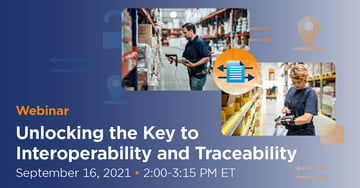Traceability is picking up steam as regulators and customers drive for transparency, brands identify the ROI, and the industry looks towards new technology adoption. Read the Current State of Traceability E-Book for a deeper dive on the movement.
The food industry is experiencing a renaissance, and safety and transparency are the cornerstones of this new direction. As consumers continue to express concern for what is in their food and federal regulations begin to reflect this sentiment, it is increasingly important for food growers, suppliers and retailers to deliver the highest quality products with the most clarity possible.
End-to-end supply chain traceability can help the industry meet these stringent requirements, maintain brand integrity, mitigate future quality issues and empower conscious consumers. We’ve assembled the Current State of Food Traceability E-Book to provide a touchstone for the growing traceability movement, featuring food safety and supply chain technology experts.
What’s Driving Traceability Adoption
Enhanced traceability has been driven forward in light of a changing regulatory landscape with the introduction of the Food Safety Modernization Act (FSMA), the most sweeping reform of food safety laws in more than 70 years. The FDA now has a legislative mandate to require comprehensive, prevention-based controls across the food supply chain.
Regulators aren’t the only ones interested in pushing traceability forward. With a few taps of a screen, consumers can learn nearly anything they would ever want to know about a food company, from nutritionals to learning if the company has had a major recall. Because of this instant access to information, consumers are demanding transparency and patronizing food companies that provide it.
The Impact of GS1 Standards
The advancement in standards for food traceability have been significant. This year marks the ten year anniversary of the Foodservice GS1 US Standards Initiative. GS1 Standards are the most widely used supply chain standards in the world, with over 1 million companies leveraging GS1 standards to remain relevant and competitive. At FoodLogiQ, we’ve captured over 23 million traceability events, and nearly 300,000 quality incidents. The implementation of GS1 standards have also proven to reduce overhead for companies. FoodLogiQ customers IPC/Subway have been able to quantify a 1.3M reduction in costs by implementing GS1 standards with FoodLogiQ Connect.
The Role of Blockchain in Traceability
Blockchain, a distributed form of database management, is often considered synonymous with transparency. While new tools and technologies can simplify complex processes, the fact remains that traceability requires all parties to be aligned with best practices and requirements for data standards, among other necessities. At the end of the day, a modernized supply chain with standardized data built on GS1 standards is imperative in preparation for becoming blockchain-ready. At FoodLogiQ, we assist organizations in their quest to modernize their supply chain in preparation for blockchain with our end-to-end traceability solutions.
Download the E-Book and Learn:
- What’s driving the adoption of food traceability
- How whole-chain traceability offers safety, transparency, and branding benefits
- The future of traceability and how the food industry is fast-tracking towards transparency
- Why implementing GS1 Standards is imperative for becoming blockchain-ready
Other posts you might be interested in
View All Posts
Food Industry
4 min read
| September 15, 2021
FoodLogiQ to Participate in Interoperability Demonstration Using GS1 Standards
Read More
Supplier Compliance
4 min read
| June 22, 2021
FoodLogiQ Joins Industry Leaders to Advance Supply Chain Interoperability and Confirm the Value of Technical Standards
Read More
Traceability
2 min read
| September 15, 2017

